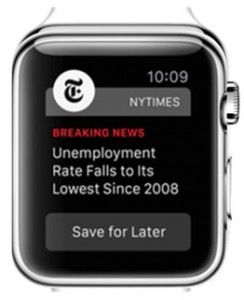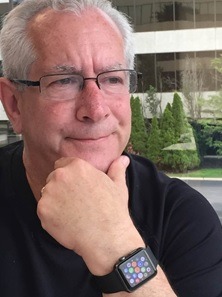 We have talked a lot in recent months about the need for speed. As we continue to be inundated with content from seemingly infinite sources, our ability to process all that entertainment and information erodes. And because many of us are constantly running – devices in hand (or on our wrists) – we have even less time to take it all in.
We have talked a lot in recent months about the need for speed. As we continue to be inundated with content from seemingly infinite sources, our ability to process all that entertainment and information erodes. And because many of us are constantly running – devices in hand (or on our wrists) – we have even less time to take it all in.
You may find yourself reading fewer long-form articles or stories, online or in print. And oftentimes, maybe the headline will simply do.
Wearers of smartwatches are experiencing this phenomenon as they adjust from having to pull a mobile phone out of a pocket, purse, or briefcase/backpack to simply glancing down at their wrist. This may seem like a minor convenience, but after some time, the ability to be up-to-date without being distracted by reaching for a phone comes more natural.
When you see the headline “American Pharoah wins the Triple Crown,” do you really need to read the entire story?
Or when your watch displays “Carrie Underwood Dominates 2015 CMT Awards,” you pretty much know the story without having to sift through a 300 word story to read the details.
Whether it’s an email notification, breaking news, a ratings update, or a message from a co-worker, most of us are thinking, moving, and breathing in a form of digital shorthand.
We’ve been experiencing that sensation since the Apple Watch arrived at jācapps World Headquarters two weeks ago. As you might imagine, we’re in the process of developing apps for this platform. And the way you get a true sense for what it is, what it does, and how it feels is to wear it.
Several staffers have taken their turn with this new gadget. And while there are different “takes” about its overall value and “game changeyness,” there is some consensus that Watch’s notification features allows wearers to be even more in touch than you are with a smartphone.
Aside from the health features, perhaps one of the most prominent positives is the gadget’s ability to quickly and effortlessly let us know what’s going on without lifting a finger or even raising an eyebrow.

And that combination of brevity and speed leads to a streamlined experience that many of us crave, whether we’re totally aware of it or not. And that shrinking envelope where information now fits on the face of a Watch goes to the heart of how our brains are being reprogrammed at digital speed.
And the compressed envelope for both content and time is permeating our day-to-day media lives, especially when we take on the role of content creators and marketers.
Pandora’s chief revenue officer, John Trimble, tells Adweek that 8-second pre-roll videos for their “Sponsored Listening” ad format is the ideal length for mobile video consumption. That would chop the current 15-second length in half, essentially pushing advertisers to communicate their messages in a much quicker window.
In the same story, Greg Manago of Mindshare says his team is up to the task, comparing Trimble’s concept to Vine’s 6 second length:
“The trick with mobile is to be engaging quickly without being annoying. You need to be very creative at this length, but we love a good challenge.”
Actually, isn’t that the trick with everything?
Whether it’s getting our point across on Twitter or delivering a great morning show break, finding ways to connect and be compelling in less time isn’t just smart for PPM meters but also to satisfy listeners as well.
That doesn’t mean talking less.
It does mean making every break count by prepping, planning, and being mindful of the audience’s increasing impatience for content that doesn’t deliver or that develops glacially.
From on-demand programming, like Netflix and podcasts, to content-skipping features in apps, like Pandora, Spotify, and NPR One, the typical listener who used to turn it on and leave it on is losing his ability to focus on programming that fails to deliver in a timely way. Spotify’s Paul Lamere tells us the likelihood that consumers listen to songs in their entirety on his service is only around 50%. It’s that digital itch that nags at many users, motivating them to flit around to find that next piece of content that will entertain or inform us.
And yet, great content that is well-written, planned, and produced turns that notion on its head. Many public radio shows prove that every day, breaking all the rules to present programming and features that go well beyond mind-numbing, repetitive speed breaks and other commercial radio rules. When you’re a consistently good storyteller, audiences will buy in and hang in. It doesn’t always work for public radio, but regular listeners will tell you that the payoffs are there more often than not.
So it doesn’t mean that long-form programming is no longer viable.
It does mean that interviews and extended segments must engage and compel. Fortunately, this happens every day in commercial radio. In the last two days, I’ve found myself listening to interviews that have kept me in the car (Drew Lane interviewing Jeff Daniels on Detroit Sports Radio 105.1) and late for a meeting (Ashley & Drew interviewing the mother of a daughter who had been missing for 72 hours on KKPT/Little Rock). These moments need to happen more often.
The stakes are higher. The bar has been raised.
Less isn’t necessarily more.
But more is rapidly become less.
- What To Do If Your Radio Station Goes Through A Midlife Crisis - April 25, 2025
- A 2020 Lesson?It Could All Be Gone In A Flash - April 24, 2025
- How AI Can Give Radio Personalities More…PERSONALITY - April 23, 2025




JacoBlog always spot on! Headlines, early & often, instant and connected build the package. You’d think there’d be a live editor working 24/7 to revamp All Broadcasting. Shame on decent companies with an FCC license (especially big metro signals and indy TV) who doesn’t get it, deliver it and sell it. Thanks, again. http://www.broadcastideas.com
Thanks, Clark!